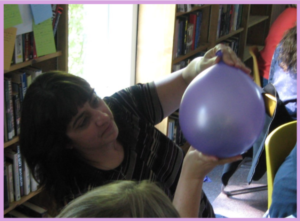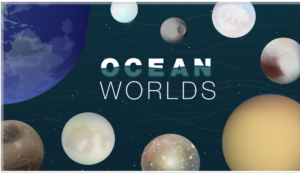
Photo credit: LPI.
STAR Net’s Our Blue Planet: EARTH campaign is a celebration of NASA’s focus on Earth’s oceans, understanding how they are changing and their impact on sea life and our weather and climate systems. Participate in this event during the summer of 2022 by sharing activities and resources with your patrons! This month’s featured activity is Investigating the Insides, an activity to study models of Ocean Worlds.
Investigating the Insides is a 10 to 30minute activity in which teams investigate the composition of unseen materials using a variety of tools. This open-ended engagement activity mimics how scientists discover clues about the interiors of planets, particularly Ocean Worlds, with cameras and other instruments onboard spacecraft. Facilitate as an in-person program at your library or as a demonstration for a virtual program.
Time to complete: This activity can be conducted through quick 10-minute observations or extended to a 30-minute program with conversations about the analogy to how we study Ocean Worlds.
Ages: 8 and up
Modification and Preparation List
Total Cost: $1 to $10, depending on the number of models created
Fundamental Space Science Concepts – Investigating the Insides relates to Our Blue Planet: EARTH:
In addition to studying our own world, NASA is exploring Ocean Worlds throughout our solar system. Our oceans make life possible on Earth. There are also several moons and dwarf planets which have salty oceans beneath icy surfaces—places where alien life could potentially exist!
To study these places, NASA sends planetary missions such as the upcoming Europa Clipper to make observations and take data, but even these instruments cannot see beneath the icy crusts to view the hidden oceans. Instead, scientists use the data they collect about the surface composition, the object’s physical properties and magnetic field to help infer the size, location, and composition of the seas and oceans.
In this activity, library patrons can make inferences about the hidden interior of “planets” made from balloons and other materials, such as magnets, water, marbles, and more. By holding and shaking their balloons, testing them with magnets, and listening to them, patrons can develop and share their ideas about which of their “planets” has a magnetic field, a dense interior, or even an ocean of liquid water!

Credit: NASA/JPL
Resources for you to use and share with patrons:
Video: Are There Oceans on Other Worlds?
Get quick highlights about the connections between water in the universe, where we find ocean worlds, and why the study of ocean worlds can help us answer our questions about life beyond Earth. 90 seconds.
Video: What You Need to Know About Ocean Worlds
Enjoy beautiful visuals highlighting the characteristics of some of the objects in our solar system that may have oceans beneath their surfaces. 2 mins, full captions.
Video: Europa: Ocean World
The oceans on Europa and how we know about them are described, as well as the connections between oceans and our search for life beyond Earth. 4 mins, downloadable, narrated.
The story of water in our solar system and beyond is told at this NASA site.
Print or share the link for NASA’s Astrobiology graphic novel on Missions to the Outer Solar System
STAR Net’s Our Blue Planet: EARTH Event Page: https://www.starnetlibraries.org/our-planet-earth/
Discover more Our Blue Planet: EARTH Toolkit activities at
http://clearinghouse.starnetlibraries.org/161-our-planet-earth
This content was written by Christine Shupla from the Lunar and Planetary Institute




Leave A Comment